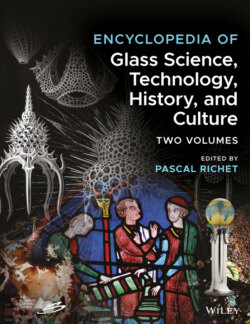Читать книгу Encyclopedia of Glass Science, Technology, History, and Culture - Группа авторов - Страница 200
6.1 Mössbauer Spectroscopy
ОглавлениеThis extremely sensitive technique relies on the recoil‐free resonant absorption and emission of gamma rays in solids (Mössbauer effect). It probes small changes in energy levels associated with the nucleus. However, only a relatively limited number of elements are suitable for study. This is because Mössbauer spectroscopy relies on the radioactive decay of a parent isotope to that of interest, which has a sufficiently long half‐life to make real‐time experiments realistic. In glasses, the most common elements exhibiting this effect are iron (57Fe) and tin (119Sn), the radioactive sources being 57Co and usually 119mSn, respectively (cf. [23]). The samples are usually powders (mg) that are mixed with some sort of inert matrix such as sucrose in order to dilute the concentration of the Fe or Sn. If the Fe or Sn concentration is too high, a useful Mössbauer spectrum will not be obtained. One can determine the oxidation state and coordination of Fe in glasses based on the analysis of the isomer shift (IS) and quadrupole splitting (QS) values extracted from Fe Mössbauer spectra. The spectra of iron‐containing glasses generally exhibit an asymmetric doublet whose full width at half maximum are larger than those of crystalline materials. A number of different models are usually fitted to the doublet (Figure 11). In early studies sets of symmetric Lorentzian curves were used to represent the different potential Fe sites but in more recent years fits of the quadrupolar splitting or hyperfine field distributions are usually preferred. Typical IS (δ) values for silicate glasses fall between 0.20 and 0.32 mm/s for Fe3+ in tetrahedral coordination, 0.35–0.55 mm/s for Fe3+ in octahedral coordination, 0.80–0.95 mm/s for Fe2+ in tetrahedral coordination, and 1.05–1.55 mm/s for Fe2+ in octahedral coordination. The presence of fivefold Fe has been observed in glasses with IS and QS values lying between those of four‐ and sixfold Fe. However, it is difficult to distinguish Fe in fivefold coordination from a mixture of Fe in four‐ and sixfold coordination.
Tin spectra are usually broad (FWHM ~1 mm/s) symmetric doublets. For Sn4+, QS values are small and the IS is close to 0 mm/s whereas Sn2+ has IS and QS values of 1–2 and 2–3 mm/s, respectively. For Sn2+, the IS is more negative for tetrahedral than for octahedral sites.
